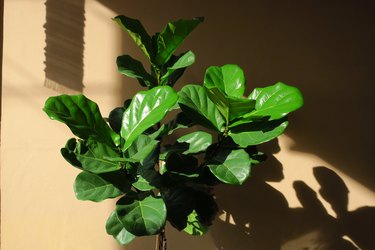
If you've ever noticed a flurry of activity from tiny gnats flying around your ficus and other houseplants as you walk by, you've seen only the adult winged stage of this insect. Its larval stage lives as tiny white worms in houseplant soil. You may also have seen these white worms in potted plants or in the drainage dishes below the pots, but perhaps you didn't make the connection between them and the gnats. As annoying as the gnats are, it's actually the presence of their tiny white larvae in houseplant soil that has the potential to damage your ficus by feeding on its roots.
Of the more than 800 species of ficus plants, many of them make good houseplants. One of these is the weeping fig (Ficus benjamina, USDA zones 10-12), introduced in the 1950s, which is one of the most popular houseplants in tree form. You may be growing another type of ficus as a houseplant, but the growing medium on which they're potted can host these worms regardless of species.
Video of the Day
Video of the Day
White Worms in Potted Plants
Those tiny white worms in houseplant soil hatch from eggs that the gnats lay in the soil or on organic debris, such as fallen leaves that accumulate on top of the soil around the plant. Called fungus gnats because the larvae feed on organic matter, such as fungi in the soil, these small flies are the final adult stage in a four-stage metamorphosis. The eggs hatch into larvae, which transform into pupae before finally completing the life cycle as adult gnats.
This entire four-stage metamorphosis cycle can be completed in only 17 days under optimal conditions. This short time frame coupled with repeating growth cycles potentially makes an infestation of fungus gnats a persistent challenge to overcome, particularly in a warm home that promotes an even quicker turnaround time to maturity. There are steps you can take to break this cycle, rid your potting mix of the white worms and clear the air of the gnats.
Ridding Houseplants of White Worms
Breaking the life cycle of fungus gnats is the way to get rid of the tiny white worms in houseplant soil. Even if you repot your ficus in new potting soil, there may still be eggs or tiny larvae attached to the roots of your plant that will re-infest the new soil. If you have other houseplants, any eggs or worms in their soil will mature to adult fungus gnats, which can fly back to your newly repotted ficus and lay eggs in the soil.
A moist environment is what allows fungus gnat eggs, larvae and pupae to remain viable. Take away the moisture and you effectively break the life cycle. Your houseplants must still be watered, of course, so allow the soil to dry a bit after you water your ficus before watering your plant again. You can also reduce watering during the fall and winter because of the plant's seasonal need for less water during these months.
Even if you don't have a problem with fungus gnats, overwatering your ficus may lead to root rot. So, if you give your ficus only a moderate amount of water and let the soil dry slightly between waterings, you can help keep it in tip-top shape.
Another Tip for Eliminating White Worms
It's also helpful to remove all fallen leaves and other organic debris that may be on top of the potting mix. Mulching plants is a sound horticultural practice in the landscape but not so much indoors because it promotes the moist conditions that allow fungus gnats to proliferate.